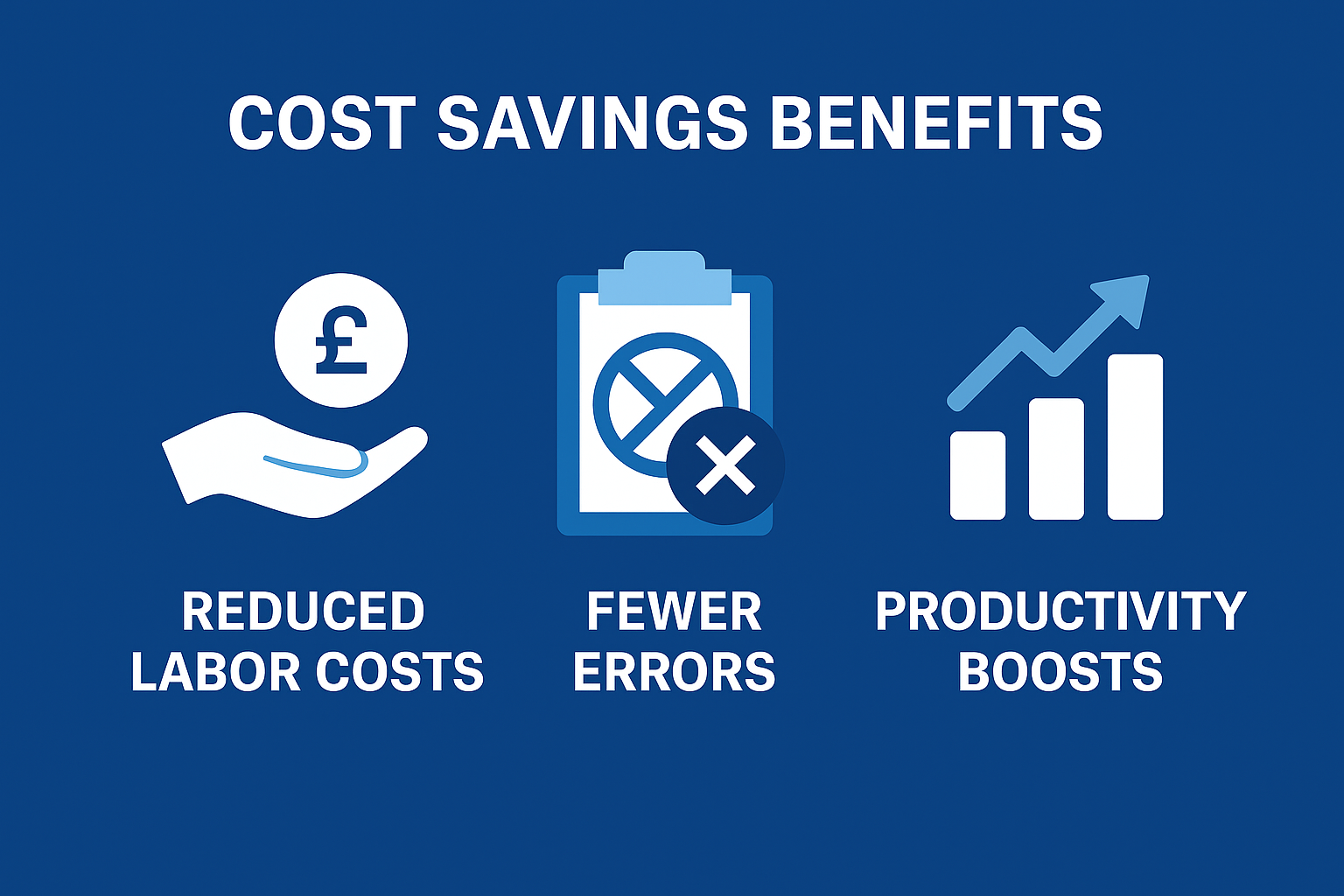For small and mid-sized businesses (SMBs) in the UK, every pound counts. Competition is fierce, resources are often stretched thin, and scaling sustainably can feel like an uphill battle. That’s why many SMBs are turning to workflow automation, not just to cut costs, but to do so in a way that doesn’t sacrifice quality or customer trust.
In this blog, we’ll explore how workflow automation for small businesses can reduce expenses, boost efficiency, and improve service delivery. Most importantly, we’ll show how it helps SMBs cut costs without cutting corners.

Why SMBs Can’t Ignore Workflow Automation
The UK’s digital economy is evolving fast, and automation is at its core. According to the UK Government’s Cyber Security Breaches Survey 2024, nearly 50% of small businesses report resource constraints when managing IT systems, a gap automation can help close (Gov.uk).
Beyond IT, studies reveal that companies implementing automation see an average cost reduction of 20–30% while also improving output quality. For SMBs, that’s the difference between surviving and thriving.
What Is Workflow Automation?
At its simplest, workflow automation is the use of software or tools to handle routine business processes that would otherwise require manual work. For small businesses, that could include:
- Sending automatic invoice reminders.
- Tracking inventory in real time.
- Automating HR onboarding tasks.
- Handling customer service queries with chatbots.
- Managing email campaigns and follow-ups.
By automating repetitive processes, SMBs free up their teams to focus on higher-value tasks, like customer engagement, product innovation, and strategic growth.
The Cost-Saving Power of Workflow Automation
1. Reduced Labour Costs
Hiring new staff is one way to manage increased workload, but it’s costly. Automation allows SMBs to scale operations without increasing headcount. For example, automating payroll or invoice management can save dozens of staff hours each month, equating to thousands of pounds annually.
2. Minimized Human Error
Manual processes often result in mistakes, whether in data entry, payments, or communication. Studies show that automation can reduce error rates by up to 50% compared to manual tasks. Errors cost money; fewer mistakes mean more savings.
3. Improved Productivity
Automation doesn’t just save time; it ensures staff are working on tasks that matter. According to Deloitte, businesses using workflow automation tools see productivity boosts of 12–15% across operations. For SMBs, this translates directly into competitive advantage.

Common SMB Workflows That Can Be Automated
Finance: invoicing, expense tracking, payroll.
Sales & Marketing: lead nurturing, CRM updates, email campaigns.
HR: employee onboarding, leave requests, performance reviews.
Customer Support: ticket assignment, chatbot responses, FAQs.
Operations: supply chain tracking, inventory updates, compliance reporting.
Cutting Costs Without Cutting Corners
One fear many SMBs have is that automation might lower quality or make customer interactions feel impersonal. But when implemented correctly, workflow automation enhances quality instead of reducing it.
- Consistency: Automated processes ensure customers receive the same quality of service every time.
- Speed: Faster responses (like instant order confirmations or support replies) improve customer satisfaction.
- Compliance: Automated reminders and checks reduce the risk of missing regulatory requirements.
Instead of replacing human touch, automation supports it, allowing employees to focus on empathy, strategy, and innovation.
Choosing the Right Workflow Automation Tools
Not all automation tools are created equal. When selecting solutions, SMBs should consider:
- Ease of Use: Low-code or no-code platforms like Zapier or Microsoft Power Automate make adoption easier.
- Scalability: Tools should grow with the business, not require replacement after a year.
- Integration: Choose solutions that integrate with existing software (CRM, ERP, HR systems).
- Affordability: Focus on tools that balance cost with functionality, tailored to SMB budgets.
A recent survey shows that 74% of SMBs using automation tools report ROI within 12 months, proving that even small-scale adoption pays off.
How SMBs Can Get Started
- Audit Current Workflows: Identify bottlenecks and repetitive tasks.
- Start Small: Automate one or two high-impact processes before expanding.
- Train Employees: Involve staff to ease adoption and prevent resistance.
- Track Metrics: Measure time saved, error reduction, and ROI.
- Scale Up: Once proven, expand automation across departments.
The Future of Workflow Automation for SMBs
Automation isn’t just a trend, it’s a survival strategy. With AI-powered tools, predictive analytics, and smarter dashboards becoming more affordable, SMBs in the UK have unprecedented access to enterprise-level efficiency at small-business prices.
SMBs that embrace automation today will:
- Cut costs without harming quality.
- Scale sustainably without overspending.
- Compete effectively with larger players in the market.
Final Thoughts
Workflow automation for small businesses isn’t about replacing people, it’s about empowering them. By eliminating repetitive, low-value tasks, SMBs can cut costs while maintaining (and even improving) the quality of their services.
At I-NET Software Solutions, we help SMBs in the UK design and implement workflow automation strategies that deliver measurable results, whether through process audits, automation consulting, or custom dashboard solutions.
Book a consultation to explore how we can help your business cut costs without cutting corners.
Related reading: Clean Data, Better Decisions: Why Data Quality Matters More Than AI Models
